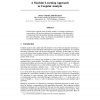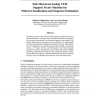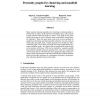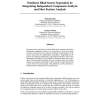NIPS
2004
14 years 29 days ago
2004
Choice-based conjoint analysis builds models of consumer preferences over products with answers gathered in questionnaires. Our main goal is to bring tools from the machine learni...
NIPS
2004
14 years 29 days ago
2004
An analog system-on-chip for kernel-based pattern classification and sequence estimation is presented. State transition probabilities conditioned on input data are generated by an...
NIPS
2004
14 years 29 days ago
2004
We provide a worst-case analysis of selective sampling algorithms for learning linear threshold functions. The algorithms considered in this paper are Perceptron-like algorithms, ...
NIPS
2004
14 years 29 days ago
2004
We study the problem of hierarchical classification when labels corresponding to partial and/or multiple paths in the underlying taxonomy are allowed. We introduce a new hierarchi...
NIPS
2004
14 years 29 days ago
2004
Many machine learning algorithms for clustering or dimensionality reduction take as input a cloud of points in Euclidean space, and construct a graph with the input data points as...
NIPS
2004
14 years 29 days ago
2004
Gaussian processes are usually parameterised in terms of their covariance functions. However, this makes it difficult to deal with multiple outputs, because ensuring that the cova...
NIPS
2004
14 years 29 days ago
2004
Learning in a multiagent system is a challenging problem due to two key factors. First, if other agents are simultaneously learning then the environment is no longer stationary, t...
NIPS
2004
14 years 29 days ago
2004
Experimental studies have observed synaptic potentiation when a presynaptic neuron fires shortly before a postsynaptic neuron, and synaptic depression when the presynaptic neuron ...
NIPS
2004
14 years 29 days ago
2004
Statistical language models estimate the probability of a word occurring in a given context. The most common language models rely on a discrete enumeration of predictive contexts ...
NIPS
2004
14 years 29 days ago
2004
In contrast to the equivalence of linear blind source separation and linear independent component analysis it is not possible to recover the original source signal from some unkno...




